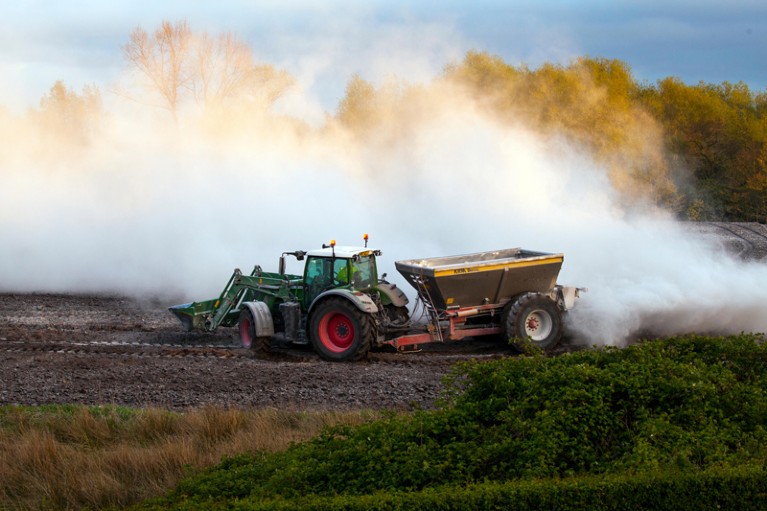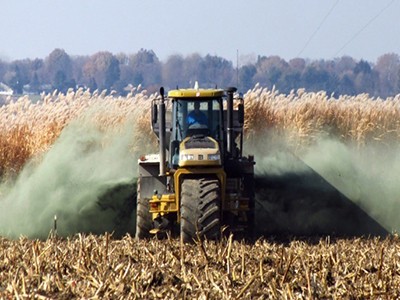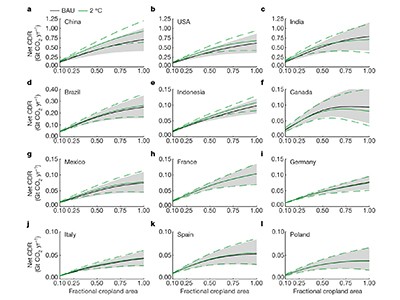
Equipment used to coat agricultural fields with limestone could also be used to spread basalt dust.Credit: Nick Hatton/Alamy
Could spreading basalt dust on farmers’ fields help to remove atmospheric carbon? A large multidisciplinary team of scientists is confident it could, and that doing so could boost crop yields and soil health at the same time.
In this issue, David Beerling, a biogeochemist at the University of Sheffield, UK, and his colleagues explore a strategy to enhance rock weathering (D. J. Beerling et al. Nature 583, 242–248; 2020).
This is a continuously occurring natural phenomenon in which carbon dioxide and water react with silicate rocks on Earth’s surface. In the process, atmospheric CO2 is converted into stable bicarbonates that dissolve and then flow into rivers and oceans. The idea of scaling up this process to remove carbon has been considered for some three decades. The team’s results provide the most detailed analysis yet of the technical and economic potential of this approach — and some of the probable challenges, including gaining public acceptance.
The researchers modelled what would happen to atmospheric carbon if basalt dust was added to agricultural lands in the world’s biggest economies, including Brazil, China, the European Union, India, Indonesia and the United States. According to their calculations, doing so would remove between 0.5 billion and 2 billion tonnes of CO2 from the air each year. The upper limit is more than 5 times the annual emissions of the United Kingdom, and akin to offsetting emissions from around 500 coal-fired power plants.
Removal of atmospheric CO2 by rock weathering holds promise for mitigating climate change
The team is also carrying out field trials in four countries — the only such trials yet. The authors have told Nature that preliminary results suggest the theory is holding up. The application of 20 tonnes of basalt dust to a half-hectare UK plot boosted CO2 removal by 40% compared with that seen on an untreated plot, and by 15% in another trial, which spread dust over oil-palm plantations in Malaysia. The early results also indicate that adding basalt boosted yields in these and other crops.
These are encouraging developments at a time when governments around the world are struggling to meet their climate commitments. The approach, if successful, could enable high-emitting countries such as the United States and China to remove some of the carbon they have pumped into the atmosphere in recent decades. Moreover, the machines that are required to spread basalt dust on fields already exist: farmers use them to treat soils with limestone.
Costing the Earth
But, like many promising technological fixes, spreading basalt dust across the world’s agricultural fields could prove more complicated than it first seems. Researchers must answer a host of pressing questions about the economic costs and environmental impacts. And there are potential questions for regulators, too.
Tinkering with the geochemical cycle will inevitably alter ecosystems in soils, rivers and even oceans. Some of this might be beneficial: rock dust of the right variety could bolster desirable plant communities, for example. And the alkaline content that runs off to the oceans could, in theory, counteract acidification, helping to protect corals and other creatures that are threatened by rising atmospheric CO2 levels. But we need to be confident that there are no harmful consequences to land and sea, and any potential effects would need to be monitored carefully.
Moreover, mining rock on industrial scales, pulverizing it and spreading the dust on crop fields will not be cheap. The current price of carbon on the European Union’s emissions trading system is less than €28 (US$31) per tonne. By contrast, Beerling and his colleagues estimate that enhanced rock weathering will cost between $80 and $180 per tonne of CO2. That said, such costs are in line with competing technologies that could be used to pull CO2 out of the atmosphere. And although rock will need to be mined, the Sheffield team is rightly calling for an inventory of free, suitable waste rock from existing mining operations. This will bring costs down, increase carbon uptake and make more efficient use of mined materials.
Citizen science
The project team also studied how members of the public would react to such technologies (E. Cox et al. Nature Clim. Change https://doi.org/10.1038/s41558-020-0823-z; 2020). From research carried out in the United Kingdom and the United States, it is clear that CO2-removal strategies could face scepticism. Respondents who took part in surveys and workshop discussions feared that they might take too long to develop, and expressed concern that the basalt dust could affect ocean ecology. Many also opposed the idea of such technologies becoming a substitute for tackling the root causes of climate change.
Read the paper: Potential for large-scale CO2 removal via enhanced rock weathering with croplands
Concerns surrounding the ecological impacts could be allayed with appropriate government oversight. But there is no intergovernmental process that is considering the full suite of issues — including safety and ethics — that will need to be addressed if carbon-removal technologies are to be applied at significant scales. The Carnegie Council for Ethics in International Affairs, a think tank in New York City, is working to build awareness among governments about the issues they are likely to face if these technologies are applied, through the Carnegie Climate Governance Initiative. Much of the group’s work has been focused on how to regulate technologies associated with the ‘geoengineering’ label, such as lofting aerosols into the stratosphere to reflect solar radiation back into space. Carbon removal, although less controversial, is just as important.
Beerling and his colleagues also deserve credit on this front. The University of Sheffield’s Leverhulme Centre for Climate Change Mitigation is 4 years into a 10-year, £10-million (US$12.5-million) research programme that includes modelling and field trials, as well as laboratory studies and public-engagement research. But the centre cannot be expected to shoulder such a heavy responsibility alone. Other groups and funders need to step up.
With the dangers of climate change becoming more apparent each year, countries must continue to pursue the aggressive action that will be required to meet the goals of the 2015 Paris climate agreement. Carbon-removal technologies cannot be a substitute for such action. But it is becoming clear that if humanity is to limit global warming to 1.5–2 °C above pre-industrial levels, it must pursue every promising idea.

 Read the paper: Potential for large-scale CO2 removal via enhanced rock weathering with croplands
Read the paper: Potential for large-scale CO2 removal via enhanced rock weathering with croplands
 Removal of atmospheric CO2 by rock weathering holds promise for mitigating climate change
Removal of atmospheric CO2 by rock weathering holds promise for mitigating climate change
 Public perceptions of carbon dioxide removal in the United States and the United Kingdom
Public perceptions of carbon dioxide removal in the United States and the United Kingdom


